Promoting and reporting on climate action carried out within the framework of the Low-Carbon Standard
In the context of the development of the Low Carbon Label, one of the recurring questions from potential financiers is: “What am I allowed to say and do when financing certified low carbon projects? With this publication, I4CE provides operational and pragmatic answers.
French agriculture lacks the capacity to single-handedly address the many challenges it faces. Its necessary transformation can only proceed if additional external funding is made available. Carbon certification frameworks, by providing guarantees on the veracity of emission reductions (ER) and the additionality of projects, are one of the tools to provide new financial resources to the sector.
France has had its own carbon certification framework since 2018, overseen by the Ministry of the Ecological Transition: the French Low-Carbon Standard (Label Bas-Carbone, LBC)1. The development of sectoral methodologies is progressing rapidly and projects have already received the standard, but it has become apparent that several clarifications are necessary to facilitate the financing of agricultural projects by agribusinesses. A recurring question asked by potential funders is “What am I allowed to say and do when financing certified low-carbon projects?” And underlying this question are many others: are there double counting problems surrounding voluntary credits and State inventories? Is there a need to distinguish between ER from inside or outside the value chain in the context of a carbon offset approach? What are the best methods of project communication when several funders are involved ?
These questions are not specific to the LBC, as they concern the functioning of all voluntary carbon markets, and nor are they new. However, they remain topical and are even the subject of numerous international debates, although no consensus has been reached. Paradoxically, these discussions, held in the pursuit of rigour and raising ambitions, are delaying the financing of projects. In the short term it is therefore necessary to provide operational answers to funders, at least in the specific LBC context. In France, these issues have mainly been raised by the agri-food industries, which is why this document focuses specifically on this sector.
Taking this into account, the aim of this study is to provide practical answers to agri-food companies that are wondering what they are entitled to say or do when financing projects within the LBC framework. Through an analysis of five project funding case types, we make recommendations on the structuring of the carbon assessment and reporting with which financing companies can engage, whether through a carbon offsetting approach or a contribution to the climate effort.
These technical recommendations made for each case type stem from three general recommendations: when financing low-carbon projects, one must seek to be cooperative,
pragmatic and transparent.
Cooperation
Neither the private sector nor the State alone has the means to finance all the projects needed to achieve the objectives that France has set itself in the framework of the Paris Agreement. Partnerships between value chains, between industrial sectors, between territories, between the private and public sectors, should be facilitated and encouraged to finance as many projects as possible.
Presenting oneself as the sole beneficiary of a financed project in terms of carbon accounting is often misleading and can be detrimental to project development. In the carbon field, everyone benefits from the actions of others. So much the better if “collateral benefits”, such as Scope 3 reductions for a third party, occur during a project’s implementation. But beware: only funders can claim responsibility for ER.
Pragmatism
Guidelines cannot be based on rules that are unverifiable in practice, as we see for the issue of double counting between Scope 3 carbon reporting and voluntary credits. It must be remembered that the framework within which companies act on climate change inherently involves a degree of uncertainty, which is limited and controlled, but nevertheless real. Perfect is the enemy of good: the search for rigour and high standards must not be at the expense of project funding.
Transparency
Transparency is the most important point and the counterpart of the first two. Being transparent about actions undertaken is the best guarantee of credibility regarding climate impact. Agribusinesses must first make a clear distinction between their carbon reporting on the one hand, and the ER purchased or financed by the organisation on the other.
Furthermore, they should report not only in tCO2e, the commonly used indicator, but also in euros, to show the amount spent on project financing. This provides additional information. Ideally, both figures should be provided, and not one or the other. Indeed, a contribution made at a carbon credit price of 5 euros, for example, is not equal to one with a credit price of 100 euros.
Finally, a funder’s communication should not anticipate the certification of ER. As soon as funding has been committed, it is possible to report in terms of euros. However, it is not until ER have been acknowledged by the Ministry that the volume of ER can be made public.
Cliquez sur ce bouton pour voir l’image
In partnership with:

